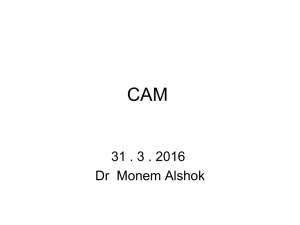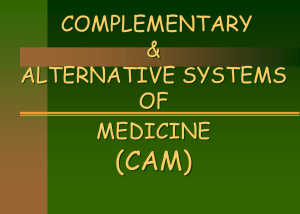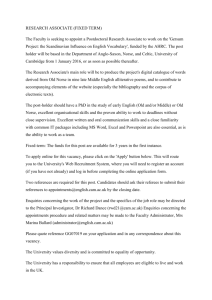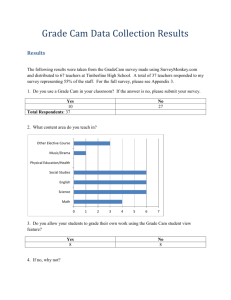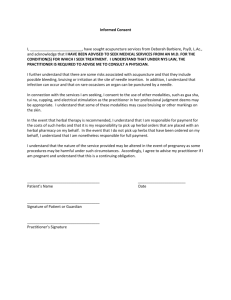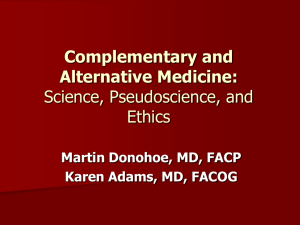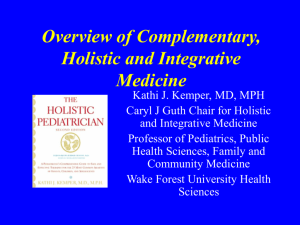Chapter 34 Complementary and Alternative Therapies in Maternity
advertisement
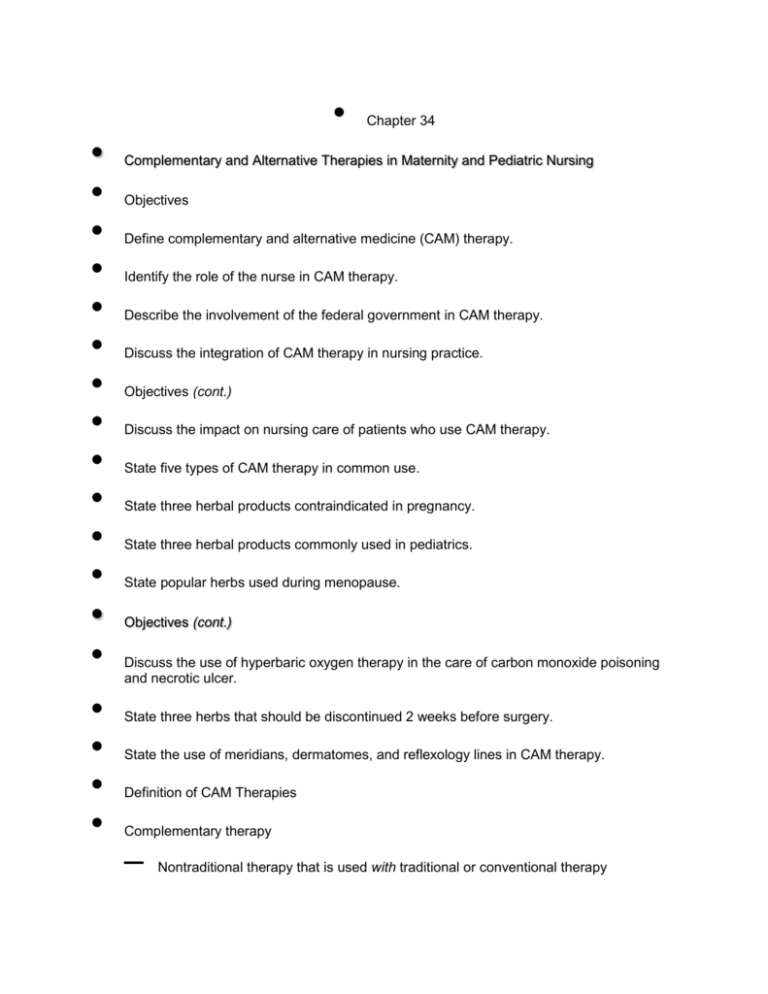
• • • • • • • • • • • • • • • • • • • Chapter 34 Complementary and Alternative Therapies in Maternity and Pediatric Nursing Objectives Define complementary and alternative medicine (CAM) therapy. Identify the role of the nurse in CAM therapy. Describe the involvement of the federal government in CAM therapy. Discuss the integration of CAM therapy in nursing practice. Objectives (cont.) Discuss the impact on nursing care of patients who use CAM therapy. State five types of CAM therapy in common use. State three herbal products contraindicated in pregnancy. State three herbal products commonly used in pediatrics. State popular herbs used during menopause. Objectives (cont.) Discuss the use of hyperbaric oxygen therapy in the care of carbon monoxide poisoning and necrotic ulcer. State three herbs that should be discontinued 2 weeks before surgery. State the use of meridians, dermatomes, and reflexology lines in CAM therapy. Definition of CAM Therapies Complementary therapy – Nontraditional therapy that is used with traditional or conventional therapy • • • • • • • • • • • • • • • Alternative therapy – Unconventional or nontraditional that replaces conventional or traditional therapy Alternative Health Care CAM Therapy Also known as – – – Integrative therapies Integrative healing Holistic healing CAM Practitioners Holistic practitioners Naturopaths Nutritional consultants – – Food therapy Vitamin and mineral supplements Herbalist Practitioners of acupuncture and acupressure Popular Cultural Folk Healers Mexican: Curanderos African American: Root doctor Asian and Chinese: Herbalist Puerto Rican: Espiritistas or santiguadoras • • • • • • • • • • • • • • • • • • Navajo: Singers Accepted Theories Gate control theory of pain relief Imagery Journaling Therapeutic touch Humor Support groups Nurse’s Role in CAM Therapy Cultural competence is a sensitivity and respect for practices and philosophies different from one’s own The need for nurses to understand CAM therapy, how it can be used, and how it may interact with or enhance traditional medical and nursing care are important Nurses need to understand basic underlying philosophies and beliefs concerning CAM interventions Nurse’s Role in CAM Therapy (cont.) Is not to promote CAM therapy but to recognize and respect its use Use critical thinking skills to determine interactions with traditional therapies Work with the patient as a partner in the delivery of health care Cautions in CAM Therapy Herbs can – Interact with cardiac drugs • • • • • • • • • • • • • • • • – – – Affect glucose control in patients with diabetes Lower the concentration of some synthetic drugs Lower the blood level of some medications for HIV/AIDS Polypharmacy should be avoided; the use of some drugs with herbal remedies can be dangerous Herbs to Discontinue Two Weeks Before Surgery Echinacea Garlic Ginger Gingko biloba St. John’s wort Ginseng Kava kava Feverfew Ephedra (ma huang) Federal Regulations 1962: Kefauver-Harris Drug Amendment Act required FDA proof of safety and effectiveness for all drugs (not including herbal products) before placing them on the market 1992: NIH formed Office of Alternative Medicine to evaluate CAM therapies 1994: Dietary Supplement Health and Education Act defined dietary supplement and prohibited claim of medicinal value 1994: DSHEA required regulations for labeling and statement that there is no FDA approval • • • • • • • • • • • • • • Overview of Common Alternative Health Care Practices Massage Thought to bolster immune response Rolfing—thought to improve muscle and bone function “Cao-gio” (coin rubbing) form of skin manipulation thought to help bring the body into healthy alignment Perineal massage in preparation for labor Effleurage—pain relief Gentle touch—for premature infants Massage (cont.) Massage and manipulative therapy are contraindicated in patients with – – – – Cancer Osteoporosis Localized infection Cardiac and circulatory disorders Because of the increased blood flow to the affected areas Osteopathy Pressure point therapy – – Certain areas of the body are connected to specific identified pressure points such as hands, feet, and ears Channels conduct vital energy through the body Energy Healing • • • • • • • • • • • • • • • • Belief that electromagnetic flow emerges from the therapist’s hand and can funnel energy into the patient The body, the mind, the spirit, and the emotions are usually involved in this form of therapy Light therapy, another form of energy, is used to treat a jaundiced newborn Reflexology Reflex points in the hands and feet thought to correspond to every organ or part of the body Acupuncture and Acupressure Complex meridians that are pathways to specific organs or parts of the body It is at these points that positive or negative energy can be realigned “Chi” energy is thought to regulate proper body function Points to avoid during pregnancy are – – – – Bottom of foot Inner lower leg Base of thumb Most areas over abdomen Homeopathy Uses plants, herbs, and earth minerals Belief that disease is an energy imbalance and that prescribed remedies assist the body to reestablish correct balance Taken sublingually Don’t combine with caffeine, alcohol, or traditional Western medicine Only one remedy is administered at a time • • • • • • • • • • • • • • • • • • • Ayurveda Ancient Hindu healing regimen Deals with biological rhythms of nature Includes music, herbs, massage, aromatherapy, and a tailored diet Aromatherapy Involves the use of concentrated fluid or the essence of specific herbs that are combined with steams or baths to inhale or bathe the skin NOTE: Concentrated pure oils can cause burns on the skin if used incorrectly Nursing Tip Lavender, chamomile, and sandalwood essential oils are useful in aromatherapy for children with chronic pain Hypnotherapy Patient enters a hypnotic state of induced sleep Under the guidance of a practitioner, specific and potentially long-lasting suggestions are given to the patient Some patients resist the trance state and are not candidates for hypnotherapy Hydrotherapy Promotes relaxation Guided Imagery Patient focuses on a specific image which can result in the reduction of stress and increased performance Biofeedback A type of relaxation therapy that enables the patient to recognize tension in the muscles via response on an electronic machine • • • • • • • • • • • • • • • • • • • • • Chiropractic Care Deals with the relationship between the spinal column and nervous system Involves nerve energy thought to be responsible for restoring and maintaining health Herbal Remedies Powerful nutritional agents Most are safe to ingest Herbal remedies consumed during pregnancy can reach the fetus Herbal capsules are about 4 times stronger than herbal teas Herbal extracts are about 4 to 8 times stronger than capsules Common Herbs Contraindicated in Pregnancy and Lactation Aloe vera Garlic Ginkgo biloba St. John’s wort Angelica (dong quai) Chamomile Feverfew Flax (flaxseed) Ginseng Kava kava Ma huang (ephedra) • • • • • • • • • • • • • • • Nettle Herbs Commonly Used in Pediatrics Blue-green algae Chamomile Ephedra Echinacea Evening primrose oil Fennel seed oil Feverfew Fish oil Ginger Ginkgo biloba Ginseng Herbs that Promote Menstruation The following herbs promote menstruation and may cause miscarriage if used during pregnancy: – – – – – – – Cascara Cohosh Goldenseal Juniper Marjoram Motherwort Mugwort • • • • • • • • • • • • • • • • • – – – – Pennyroyal Sage Senna Wormwood Popular Herbs Used in Menopause Black cohosh Sage Dong quai Chasteberry Motherwort Hyperbaric Oxygen Therapy Uses an airtight enclosure to provide compressed air or oxygen under increased pressure Contraindicated in pregnancy Sauna/Heat Therapy Thought to help eliminate body waste Patients should monitor their pulse during this form of treatment This type of therapy is contraindicated in pregnancy Question for Review What are some CAM therapies that are currently used regularly in the labor unit? Review Objectives • • • • • Key Terms Key Points Online Resources Critical Thinking Questions Review Questions
